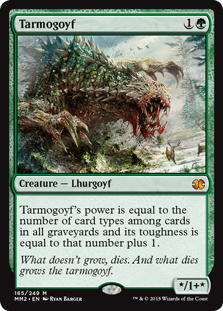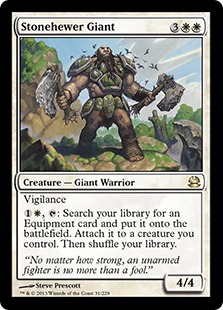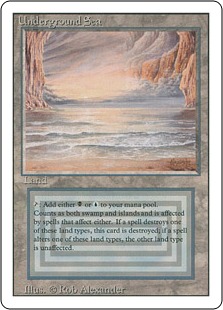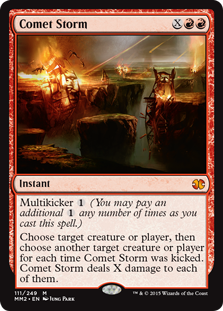Welcome back to Magic Gatherings!
By the time you read this, we’ll be just hours away from the biggest Magic organized play event in history: Modern Masters Weekend. This worldwide Magic-Palooza features near-simultaneous Grand Prix tournaments in three cities across the globe: Utretcht, Chiba, and Las Vegas. All told, close to 20,000 players will be sleeving up sealed pools this weekend, in search of everlasting glory, a Grand Prix title, and maybe—just maybe—a foil [mtg_card]Tarmogoyf[/mtg_card].
What’s all the fuss about? Last week Wizards released Modern Masters 2015 Edition, a reprint-only set with two (somewhat contradictory) aims: to add more copies of some of the rarest and most valuable Modern staples into the worldwide Magic card pool, and to provide a limited-play environment that combines the best elements of the past ten years of Magic sets into a complex, nostalgic play experience. All this arrives to you in your Friendly Local Gaming Store in the form of those quirky $10 cardboard card packs you may have seen already.
Does Modern Masters 2015 Edition accomplish either (or both) of these goals? Well, that’s what we’re here to talk about.
Grab a drink and a comfy seat! There’s lots to discuss.
Eternally Yours
To start off, we’ll pick on two words from that introduction above: “reprint only.”
Every card in Modern Masters 2015 Edition (hereafter MM2) is one that has already appeared in a previous Magic set. Why would Wizards reprint a bunch of cards people have already seen? And why would anyone buy them?
The short(-ish) answer is that Modern, the tournament format for which Modern Masters is named, is a non-rotating format. Cards printed after a (somewhat arbitrary) cutoff date, around 2003, are all fair game, and new cards from new sets don’t push out older cards. Compare that to Standard, the most popular tournament format, which is essentially “the last two years of sets”—in Standard, older cards are gradually removed from play. (If you want to find out more about Magic tournament formats, check out this article.)
Non-rotating formats have several things going for them: first, those cards that leave Standard have somewhere to go. This is an important part of Magic’s economic model, as a recent Planet Money podcast describes. There is a much larger card pool, with many interesting, powerful cards. With so many cards to choose from, you can choose the very best tool for any task. The decks are strong, the choices are difficult, and the games satisfyingly complex.
Non-rotating formats also have a big knock against them: card availability. For example, one of the format’s staple creatures—the fabled [mtg_card]Tarmogoyf[/mtg_card] I mentioned above—fetches north of $180 per copy.
 The issue is that [mtg_card]Tarmogoyf[/mtg_card] was originally printed in Future Sight, a small set released in spring 2007, about a year and a half before Magic really started taking off. There are just not very many [mtg_card]Tarmogoyf[/mtg_card]s out there for the people who want to play Modern—and consequently, they command a high price.
The issue is that [mtg_card]Tarmogoyf[/mtg_card] was originally printed in Future Sight, a small set released in spring 2007, about a year and a half before Magic really started taking off. There are just not very many [mtg_card]Tarmogoyf[/mtg_card]s out there for the people who want to play Modern—and consequently, they command a high price.
So reprint sets like MM2 are ways for Wizards to periodically supplement these important, high-demand, low-supply cards. And since the staples getting reprinted are high-demand, low-supply, they can be very valuable. In addition to [mtg_card]Tarmogoyf[/mtg_card], MM2 features cards like [mtg_card]Vendilion Clique[/mtg_card] ($60), [mtg_card]Cryptic Command[/mtg_card] ($45), [mtg_card]Noble Hierach[/mtg_card] ($45), and more. The possibility of opening these pricey treasures helps to explain MM2’s $10-per-pack price point.
So this is basically the Magic equivalent of the PowerBall, right? Crack a pack and maybe win a $180 [mtg_card]Tarmogoyf[/mtg_card]? What’s not to love? Well, stay with me.
The Last Modern Masters
Let’s pick on two more words from the intro paragraphs: “2015 Edition.” As you might have guessed (or known) already, this isn’t the first time Wizards has tried a Modern Masters reprint set. The first Modern Masters (hereafter MM1) debuted in 2013. It was an experiment in reprinting Modern staples on a large scale, the first Wizards of the Coast had tried in a long time, dating all the way back to the infamous Chronicles expansion.
Chronicles, released in 1995, was a well-intentioned misstep from a fledgling Wizards of the Coast. Way back when Magic was first released, sets would sell out almost instantly. Many players who missed the initial releases found it impossible to find the cards. Not wanting these players to be left out, WotC reprinted cards from Magic’s four earliest expansions. This was met with a fair amount of backlash from players and collectors, whose expensive original versions lost value.
As damage control, Wizards promised not to do more reprint-only sets, and established a “reserved list”—cards that they promised they wouldn’t reprint, ever. (The reserved list still exists, and in fact is indirectly responsible for the creation of the Modern format itself—eternal formats like Legacy can’t handle tournaments on a wide scale, because so many staple cards can’t be reprinted. Many key Legacy lands are on the reserved list, for example, so a Legacy manabase can easily cost more than $2000.)
Aware of this history, Wizards played it safe with MM1: conservative print runs, and an MSRP of $7 per pack, in the hopes of making a limited-release reprint set that wouldn’t crater existing card prices. To give the set more reason to exist, they designed it to also be a robust booster draft format.
And supposedly it was—if you could find any of it. The issue with MM1 was that the set was so full of value, and so little was printed, that the packs usually sold for more than $7—sometimes $10, often as much as $12. Some Magic players, being the financially savvy bunch they are, bought boxes and set them aside, hoping the prices would increase even more over time, limiting an already small supply. Packs went quickly, even at the inflated price point. I was able to do two drafts, myself, at $50 for the pair—which, as things played out, wound up being a steal.
That said, MM1 mostly accomplished what it was designed to do—prices of key staples dipped, then recovered. MM1 also reprinted a number of casual cards whose prices had previously been high only due to scarcity.
MM2: The Variancing
So how does MM2 stack up to its predecessor, in terms of the set’s value and overall composition? How does it work as a vehicle for infusing reprints into the market?
As you may have noticed, they increased the price of each booster, from $7 (MM1) to $10 (MM2). As it happens, the expected value of the cards in those packs are almost exactly the MSRP of a Modern Masters pack. I’m inclined to agree that this is by design, and I think it’s meant to prevent the kind of box hoarding and price increases that were a problem with MM1. If you buy a $10 pack of MM2, you can expect to open—on average—$10 of value, so there’s no reason to charge more. And since the expected value will decrease slightly as the set is opened, it’s not as attractive to sit on the boxes.
As for what’s in the set, MM2 hits most of the pricey staples players expected. [mtg_card]Tarmogoyf[/mtg_card], [mtg_card]Cryptic Command[/mtg_card], et al. are back for another go-round from MM1. Even better, the mythic rares in MM2 are almost all exciting, expensive, splashy cards; MM1 included the Kamigawa dragon cycle, which were cool, but not valuable, and the source of some sour feelings. With MM2, if you open a mythic, odds are you’ll be extremely happy—almost all of them are $20 or more, and they range all the way up to that flirty [mtg_card]Tarmogoyf[/mtg_card].
The issue is that these expensive mythics are responsible for most of the value in the set, and if you don’t open one of them, it is very likely your rare will be worth $2, not $20. In fact, a lot of the rares aren’t even worth $2—you’re just as likely to walk away with a $.50 bulk rare.
This is my major criticism of the set composition, then: there are very few mid-level rares and uncommons to buoy up the value of packs that don’t contain chase cards. Not every pack is going to be a winner, of course—that’s part of the game. But with MM1, the set was stuffed with cool casual rares; some were valuable due to prior scarcity, as I mentioned above, and some were just interesting cards that were useful in Commander or other casual formats.

Stonehewer Giant dropped to $2 after Modern Masters released, and today does good work in my Nahiri Commander deck.
MM1 also included a lot of commons and uncommons that were staple cards in tournament-winning Modern decks—powerful, versatile cards like [mtg_card]Kitchen Finks[/mtg_card], [mtg_card]Eternal Witness[/mtg_card], and [mtg_card]Path to Exile[/mtg_card]. This meant that players felt they were getting into the format, just by opening a few packs. I didn’t find any valuable cards in either of my two MM1 drafts, but I did finish with a Finks, a Witness, an [mtg_card]Electrolyze[/mtg_card], a [mtg_card]Murderous Redcap[/mtg_card], a [mtg_card]Relic of Progenitus[/mtg_card], a [mtg_card]Narcomoeba[/mtg_card], a [mtg_card]Lightning Helix[/mtg_card], and a few other goodies.
MM2, by comparison, is feast or famine: you hit a big-ticket card, or you get almost nothing. That makes cards that were passed over for reprints—particularly [mtg_card]Gitaxian Probe[/mtg_card], a $3 common, and [mtg_card]Serum Visions[/mtg_card], an $8 (now $10) common, feel particularly glaring.
Since it seems Wizards was trying hard to keep the expected value of MM2 packs close to the $10 retail price, I recognize that they were in a tough position here. They only have so much value to fill up, and once the sine qua non cards are in, and they fill out the mythic slots with sweet cards like [mtg_card]Elesh Norn, Grand Cenobite[/mtg_card] and [mtg_card]Kozilek, Butcher of Truth[/mtg_card], there’s not much value left to get passed down to lesser rares, uncommons, and commons.
As other writers have pointed out, though, when that’s the case, variance becomes a huge problem. I suspect many players will do just a few drafts of MM2, or buy just one box, if it’s in their budget. If they are unlucky and open more $.50 rares than they expect, the entire experience will be a big loss. Case in point, I’ve done two $40 MM2 drafts so far, and to show for it I have an $8 [mtg_card]Blinkmoth Nexus[/mtg_card] and a $2 [mtg_card]Mirran Crusader[/mtg_card]. If I weren’t doing those drafts on store credit, they would be impossible to justify; as it is, they still don’t look like wise financial decisions.
That aspect of MM2—that variance is an issue, and that it’s easy to open three packs and get $3 worth of cards for the $30 spent—comes into conflict with the other aim of the set: to be a deep, interesting, fun limited format. And that’s a shame, because it looks like MM2 certainly could be a deep, interesting limited format. I’m just not sure who will be able to afford enough drafts to find out.
Right! Yes! You can also draft this set, rather than open it like so many lottery tickets. Let’s take a quick look at the limited archetypes, and then I’ll share my insights from the drafts I’ve done so far.
MM2 Limited Play
First, the archetypes. As is apparently standard practice with Magic sets these days, Wizards has “seeded” various plans to draft around for each color pair. You don’t have to draft to play these archetypes, but these synergies will often pull you into a color pair and into a deck with a cohesive plan.
- White-Blue: This pair centers around artifacts, and features the return of both the metalcraft and affinity mechanics. Powerful payoffs include cheap beaters like [mtg_card]Court Homunculus[/mtg_card] and [mtg_card]Ethercaste Knight[/mtg_card].
- Blue-Black: This pair shares the proliferate mechanic, which lets you add extra counters to whatever you have in play. The deck seems confused in practice; usually blue-black has a surfeit of removal and card drawing spells, but in MM2 both are harder to come by.
- Black-Red: This pair creates a very aggressive deck. It’s built around the bloodthirst mechanic and showcases cards like [mtg_card]Blood Ogre[/mtg_card] and [mtg_card]Gorehorn Minotaurs[/mtg_card], which can snowball out of control quickly. Black’s proliferate spells mean you can add extra +1/+1 counters to these guys.
- Red-Green: This pair looks to be built around five-color play and the domain mechanic, which rewards you for having all five basic land types in play (see [mtg_card]Tribal Flames[/mtg_card] and [mtg_card]Matca Rioters[/mtg_card]). There are also big ramp targets like [mtg_card]Pelakka Wurm[/mtg_card], and Red has [mtg_card]Inner-Flame Igniter[/mtg_card], which combines well with green’s token-generating cards like [mtg_card]Nest Invader[/mtg_card], [mtg_card]Kozilek’s Predator[/mtg_card], and [mtg_card]Scatter the Seeds[/mtg_card].
- White-Green: More of an obvious token strategy, there are a few cards with convoke to pay off having lots of bodies around, as well as incentives like [mtg_card]Fortify[/mtg_card]. There is [mtg_card]Overwhelm[/mtg_card], which would seem to make your tokens good, but I have never liked that card, not even when it was first printed in Ravnica.
- White-Black: Kamigawa’s spirit tribe makes a triumphant return here, this time with cute cross-block synergies with Changeling cards like [mtg_card]Nameless Inversion[/mtg_card] (which is a Spirit, even if it doesn’t obviously say so). Fun fact: [mtg_card]Thief of Hope[/mtg_card] was the first card I ever picked in the first booster draft I ever did.
- Blue-Red: This pair is loosely oriented around Elementals, powered by [mtg_card]Smokebraider[/mtg_card]. I am not in love with [mtg_card]Cloud Elemental[/mtg_card] in this set, but the pair has some powerful uncommons in [mtg_card]Air Servant[/mtg_card] and [mtg_card]Mulldrifter[/mtg_card].
- Black-Green: This pair takes green’s token-generating cards and combines them with cards that ask you to sacrifice creatures, like [mtg_card]Plagued Rusalka[/mtg_card] and [mtg_card]Bone Splinters[/mtg_card]. This seems like it will be a slow but powerful strategy. [mtg_card]Bone Splinters[/mtg_card], by the by, is one of the few kill-it-dead-period removal spells in the set.
- Red-White: Often known as the all-stops-out aggro pair, this time we get a fun twist: most of red-white’s creatures have double strike, which means they can hit very hard with a few equipment lying around—or maybe a [mtg_card]Goblin War Paint[/mtg_card]. This pair can be aggressive, but it also has a combo feel, since you can plink away for two or four damage at a time and then suddenly end the game with a sixteen-point double strike attack.
- Green-Blue: This pair features another cool cross-block mechanical synergy, as graft cards from the original Ravnica combine with proliferate cards from Scars of Mirrodin. When your creatures all have +1/+1 counters, a [mtg_card]Thrummingbird[/mtg_card] attack grows your entire team—permanently. Don’t forget that cards like [mtg_card]Helium Squirter[/mtg_card] can target any creature with +1/+1 counters, so if you wind up dabbling in bloodthirst, you might have some extra fun.
All in all, MM2 puts a lot of very cool ideas into play. There are tons and tons of creative reprises of past mechanics, and the set combines nostalgic elements like graft and spiritcraft with newer ideas like Changeling and proliferate. That gives the best of both worlds: what’s old is familiar, but also new again. As a player with a pauper Cube (a high-powered, commons-only make-your-own-draft format), I’m impressed by the creativity on display, and inspired to try some new things.
Composition Questions
That said, there are some curious omissions here, which makes the set’s composition feel off. Green and red share the domain theme, so a card like [mtg_card]Wild Nacatl[/mtg_card] would have been a reasonable inclusion. There is a heavy emphasis on artifacts, so something like [mtg_card]Memnite[/mtg_card], [mtg_card]Signal Pest[/mtg_card], or [mtg_card]Vault Skirge[/mtg_card] would have made some sense. Reprinting these commons wouldn’t have affected the overall value of the set much, but they would have helped replicate that feeling that MM1 gave, that at the end of the draft you had a few cards toward an actual modern deck.
The rares, too, feel like a host of missed opportunities. There are a number of cards like [mtg_card]Battlegrace Angel[/mtg_card] and [mtg_card]Surrakar Spellblade[/mtg_card], which don’t clearly support themes in the set. There are also cards like [mtg_card]Overwhelming Stampede[/mtg_card] and [mtg_card]Mirror Entity[/mtg_card], which do their jobs, but don’t really excite, because we’ve seen them before, and recently. Something older, like [mtg_card]Glare of Subdual[/mtg_card], would have at least been a cool card to open—nostalgic for older players who remember how good it was, and maybe something newer players weren’t aware of. And as with the commons and uncommons, I can’t help but feel a few choice mid-level rares—[mtg_card]Steel Overseer[/mtg_card] comes to mind—would have played well and been good to open, without breaking the bank.
MM2 at Play
As for drafting and playing the set, it’s a challenging, fun experience. Committing to your colors or to a single strategy early has not worked well for me. In one draft, I fell into white-red because of a few late [mtg_card]Burst Lightning[/mtg_card]s, and subsequently got passed powerful cards like [mtg_card]Boros Swiftblade[/mtg_card]. In the other, I opened [mtg_card]Necroskitter[/mtg_card], was passed [mtg_card]Cranial Plating[/mtg_card], and tried to force base-black artifacts, passing quality cards like [mtg_card]Air Servant[/mtg_card] for black removal; that deck was underwhelming and had a tough time winning.
What’s especially interesting is that many of the cards feel like they have a reasonable floor, but a high ceiling. Take [mtg_card]Sunspear Shikari[/mtg_card] (not its art, though) or [mtg_card]Runed Servitor[/mtg_card]—they’re fine as 2/2s, but get better in the right deck. Over on Star City Games, Sam Black suggests that each strategy has a few cards that are fine if you dabble, and others that force you to commit; one key to drafting is recognizing that your [mtg_card]Moonlit Strider[/mtg_card]s can be fine in a deck with a few [mtg_card]Nameless Inversion[/mtg_card]s, but that [mtg_card]Waxmane Baku[/mtg_card] demands a lot of friends to play with. Paying attention to the cards that are being passed around late in packs can clue you in on open archetypes; in the meantime, you take the cards with reasonable worst-case scenario, and wait to go all-in until the payoff cards show up late.
Playing games was also very fun. There are lots of smaller creatures and lots of spells that kill smaller creatures, so the games were interactive. My opponents and I could each assemble powerful boards with lots of synergy, but also fight to disrupt each other. At the same time, it wasn’t possible to play around everything, which meant that games came down to informed decisions about when to take a risk to claim victory. That’s high praise in my book.
Mastering Modern Masters 2015
In spite of the fun limited play, though, I circle back to what I said above: it’s hard to sing the praises of this set’s draft environment when it’s so hard to justify paying $30 or $40 to actually draft it. My two MM2 drafts are probably all I’ll ever do.
The high price point makes each questionable inclusion or omission subject to that much more scrutiny; no one likes opening junk rares, though we accept that it happens. But opening a [mtg_card]Wolfbriar Elemental[/mtg_card], when I already have one from last summer’s Conspiracy drafts, feels especially irksome. Ending a draft with a pile of [mtg_card]Matca Rioters[/mtg_card] instead of a few [mtg_card]Wild Nacatl[/mtg_card]s makes an actual Modern deck feel that much further away.
And ultimately, that might be the biggest frustration of Modern Masters 2015 Edition: I don’t think it works well as an outreach initiative. The first Modern Masters raised interest in the format, and its cards backed that up. This set is fun to draft, but it really makes me want to play more Cube. For all the work #MakeMagicHistory is doing on Twitter today, I will be surprised if many GP Vegas participants try to turn a [mtg_card]Karn Liberated[/mtg_card] and an [mtg_card]Expedition Map[/mtg_card] into a tournament-winning Tron list—toss in a few [mtg_card]Sylvan Scrying[/mtg_card] or some Urza’s lands, and we might be able to talk.
Still, if you have the opportunity to draft without breaking the bank, MM2 is a fun set to try. If you’re at GP Vegas already, have a great time! May all your foils be [mtg_card]Tarmogoyf[/mtg_card]s.



